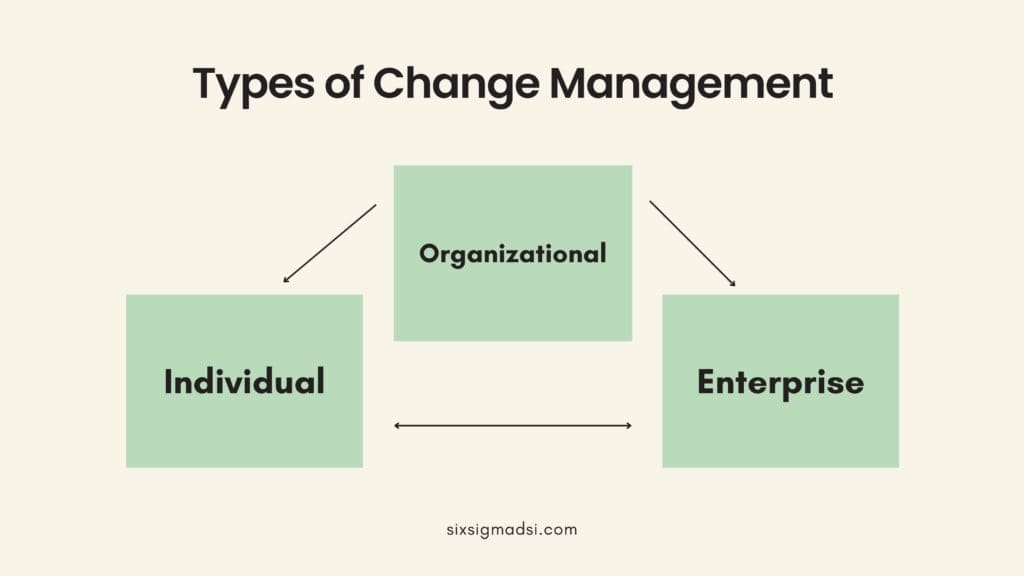Table of contents
No one enjoys change. Changes may be unavoidable or necessary, but they are difficult for employees. Changes can be as simple and straightforward as rearranging your office, or they can be complex like revamping an existing production process. If your employees avoid change, the organization is at risk. Lean Six Sigma certified is a methodology concept that focuses on bringing new and innovative 5S line changes into your company to improve efficiency. Six Sigma is also impossible without change management models. But implementing Six Sigma alone won’t guarantee a smooth change. You may need more. Change Management is a great way to integrate your Six Sigma methods with change.
What is Change Management?
Change management, by definition, is the process of guiding change at all levels – from corporate to individual. It is geared towards preparing employees to accept change, providing them with resources, and supporting any weaknesses. Accepting change is the only way to make it happen. It also encourages internal change. A professional change manager can be hired to ensure that the changes are successful, depending on the structure of your organization. If not, managers at the top will be responsible for preparing and integrating your organization to change.

Types of Change Management
Three areas are affected by the change.
Individuals
First, we look at each individual. This section focuses on the individual employee, and how to predict their adaptability to change. Even if your employees are resistant to change, personal guidance can help. The process of individual change management involves assessing what each employee or group needs to be successful in a change. It may be in the form of extra training, formal procedures, or just asking questions. Yellow Six Sigma Belt and Green employees will supervise this data collection, as individual change management relies on multiple data sets. They will be responsible for mining and organizing data to provide it to upper-level managers.
Organizational
The second type is organizational. It is important to know what each employee requires for the successful integration of change, but this can be time-consuming. Organizational change management is a way to combat this. It focuses on assessing a process, a project team, or an organization to see where the changes will be most noticeable. Each department will not experience the same amount of change. It’s therefore important to recognize and understand where the change will occur, who will be impacted, and how you can mitigate it. Lean Six Sigma certified Black Belts or higher will be responsible for managing organizational line change. These employees are the best at identifying and implementing change because they are natural project managers and leaders.
Enterprise
Enterprise change management is the last. This type of change management is a result of the structure and culture of an organization. Enterprise change management determines how easily and fluidly your organization can adapt to changes consistently. This type of change is not as obvious or visible because it is dependent on the organization. Your organization will be better prepared to handle future changes if you have a good leadership style and a proper management system.
Change Management Tools
We’ll look at some tools that can help you implement a change effectively.
1. Stakeholder Analysis
Stakeholders include people who are affected in some way by an organization. Stakeholders are affected on different levels. Owners and managers are core stakeholders. Next, stakeholders may include suppliers, customers, partners, employees, or other parties. Local communities, associations, and media could also be included as a layer. A third layer could be the public. The layers are dependent on the extent to which each is affected by an organization.
2. Readiness Assessment
The Readiness Assessment is another tool to help with 5S lean six sigma concept change management. This tool assesses the readiness for the change. Consider asking yourself the following questions.
- Does the vision seem clear?
- Is the vision being communicated effectively?
- Are employees open to change?
- Are the resources needed for change available?
- Are employees prepared for the changes?
3. Communication Plan
We will now discuss the communication plan as our third tool for lean six sigma certified change line management. When it comes to managing change, you will need a communication plan that is specific and written down. List all stakeholders who are affected by the project. For example employees, families, managers, media, etc.
Employees are the main stakeholders in this example because they will be most affected by the proposed changes. Decide how each stakeholder is going to be affected by this project. The media, for example, might have a low impact on this new change. You need to determine what message you would like to send to this specific group of stakeholders.

Change Management Models
1. Lewin’s Model
According to Lewin’s theory, to make a change you must first unfreeze the object, then make your change and refreeze.
Unfreeze is the act of accepting that a change is necessary and preparing people for it.
Next, you will need to implement the changes. Make sure all stakeholders are included in the changes.
Once you have made the necessary changes, you must refreeze your process. The process is frozen again to ensure that the changes are incorporated into the normal process. If you need to train, then do so to get people used to the new working style.
Once the change has been implemented successfully, you can celebrate it.
2. Kotter Model
Kotter’s eight steps model is similar to Lewin’s change management model. These steps are very similar to those we learned in Lewis’ model but with a little more detail.
A Climate for Change
1. Increase Urgency – The first step to take is to increase the urgency. It is difficult to make a change if there is no reason for it. For example, a falling market share or a falling profit margin could create urgency.
2. To make the change, you need a team. If you were working on a 5S Lean Six Sigma Change Management Line Project, you’d already have a team concept in place with certified management support.
3. You can get the right vision by using the facts and data you’ve collected. By implementing the change, the defect rate will be reduced by one-tenth.
Engagement and Enabling Organization
4. Communication is key to securing buy-in from your stakeholders. The change team must communicate with stakeholders.
5. Empower Action: Remove any obstacles that may be in the way of the change being implemented.
6. Create short-term wins: Look for the first sign of success that will motivate people to follow your vision.
Implementing Change and Sustaining It
7. Do not let up: No matter what changes you make, people will tend to return to the old process or the standard. Keep on pushing for the new version or new process.
8. Make sure the change sticks: Be sure to make it stick. You may need to alter your work practices or processes. Training may be required. It may be necessary to communicate the importance of change from management in six sigma certified.
How have you implemented Change Management in Six Sigma?
Let us know in the comments below.



